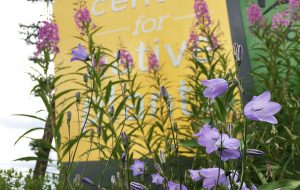Capture the Crown of the Continent Ecosystem in Your Own Landscapes
Written by Brian Schott, author, publisher, photographer, and managing editor of the Whitefish Review.
Spring has sprung and 12,000 new seeds planted last fall are taking root at the Center for Native Plants, Flathead Valley’s only retail native plant nursery in close proximity to the Crown of the Continent Ecosystem.
Andrew Beltz, Greg Gunderson, and David Noftsinger founded the Center for Native Plants in 2007 as an offshoot of their restoration and landscape company, Forestoration, Inc., founded in 2002. During the first five years while working on land restoration projects throughout the Crown of the Continent ecosystem, the team began to appreciate the beauty and broad diversity of native plants, as well as their many benefits.
This passionate team now grows a diverse collection of plants—over 150 different species of wildflowers, grasses, shrubs, and trees—that are native to Montana and the intermountain Northwest. Since the plants are grown, sown, and then overwinter outdoors, they are hardy and well-adapted to local climate extremes.
“This is an exciting time for us,” said Noftsinger. “The Center has been nearly a decade in the making. We purchased the property at our current location three years ago, and just got our business sign out on the highway last fall. We are looking forward to this next phase of being a more established company.”
Growing a company like this takes hard work, foresight, and patience. Years of research and development have shown the team what they can grow—iconic native plants like Indian Paintbrush—as they experiment with different soils and alkaline levels. The team is always looking many seasons ahead, which is why the retail floor now has robust plants that have been growing for years.
 Native plants are sturdy and conserve water, as they require little to no irrigation. Other maintenance needs are low—such as fertilization and pruning—since the plants are adapted to the local soil and environment. Not only are these plants hardy, they are beautiful and help keep native pollinators like bees, butterflies, and hummingbirds thriving. Ultimately, they create a sense of place for homeowners.
Native plants are sturdy and conserve water, as they require little to no irrigation. Other maintenance needs are low—such as fertilization and pruning—since the plants are adapted to the local soil and environment. Not only are these plants hardy, they are beautiful and help keep native pollinators like bees, butterflies, and hummingbirds thriving. Ultimately, they create a sense of place for homeowners.
Greg Gunderson likens the business to a homegrown project that started at a hobby level and is finally blooming. “You can only learn things one year at a time,” says Gunderson. “We can observe what hurts a certain plant and improve our techniques. It’s a process—we have moved slowly to learn what works and then apply that knowledge.”
Like a native tree that grows in the forest, Gunderson makes the analogy that during the first several years after a seed has sprouted, little growth is seen above ground while the root system is developing.
“Visible and exponential growth takes off only after several years,” he says. “Because we have made careful observations of natural systems, we’ve focused on the roots of our business. Now we are at that threshold where the growth is about to take off.”


